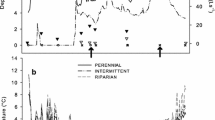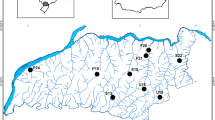Abstract
Particulate organic matter is the major source of energy for most low-order streams, but a large part of this litter is buried within bed sediment during floods and thus become poorly available for benthic food webs. The fate of this buried litter is little studied. In most cases, measures of breakdown rates consist of burying a known mass of litter within the stream sediment and following its breakdown over time. We tested this method using large litter bags (15 × 15 cm) and two field experiments. First, we used litter large bags filled with Alnus glutinosa leaves (buried at 20 cm depth with a shovel) in six stations within different land-use contexts and with different sediment grain sizes. Breakdown rates were surprisingly high (0.0011–0.0188 day−1) and neither correlate with most of the physico-chemical characteristics measured in the interstitial habitats nor with the land-use around the stream. In contrast, the rates were negatively correlated with a decrease in oxygen concentrations between surface and buried bags and positively correlated with both the percentage of coarse particles (20–40 mm) in the sediment and benthic macro-invertebrate richness. These results suggest that the vertical exchanges with surface water in the hyporheic zone play a crucial role in litter breakdown. Second, an experimental modification of local sediment (removing fine particles with a shovel to increase vertical exchanges) highlighted the influence of grain size on water and oxygen exchanges, but had no effect on hyporheic breakdown rates. Burying large litter bags within sediments may thus not be a relevant method, especially in clogged conditions, due to changes induced through the burial process in the vertical connectivity between surface and interstitial habitats that modify organic matter processing.




Similar content being viewed by others
References
APHA, 1976. Standard Methods for the Examination of Water and Wastewater, 14th edn. American Public Health Association, New York.
Barnes, H. & A. R. Kollard, 1951. The Determination of Nitrite. National Council for Exploration of the Sea, Charlottenland.
Benfield, E. F., J. R. Webster, S. W. Golladay, G. T. Peters & B. M. Stout, 1991. Effects of forest disturbance on leaf breakdown in southern Appalachian streams. Verhandlungen des Internationalen Verein Limnologie 24: 1687–1690.
Beschta, R. L. & W. Jackson, 1979. The intrusion of fine sediments into a stable gravel bed. Journal of Fisheries Research Board of Canada 36: 204–210.
Boulton, A. J., 1993. Stream ecology and surface-hyporheic hydrologic exchange: implications, techniques and limitations. Australian Journal of Marine and Freshwater Research 44: 553–564.
Boulton, A. J. & P. I. Boon, 1991. A review of methodology used to measure leaf litter decomposition in lotic environments: time to turn over an old leaf? Australian Journal of Marine and Freshwater Research 42: 1–43.
Boulton, A. J. & J. G. Foster, 1998. Effects of buried leaf litter and vertical hydrologic exchange on hyporheic water chemistry and fauna in a gravel-bed river in northern New South Wales, Australia. Freshwater Biology 40: 229–243.
Boulton, A. J., S. Findlay, P. Marmonier, E. H. Stanley & M. H. Valett, 1998. The functional significance of the hyporheic zone in streams and rivers. Annual Review of Ecology and Systematic 29: 59–81.
Bramley, R. G. V. & C. H. Roth, 2002. Land-use effects on water quality in an intensively managed catchments in the Australian humid tropics. Marine and Freshwater Research 53: 931–940.
Brunke, M., 1999. Colmation and depth filtration within streambeds: retention of particles in hyporheic interstices. International Review of Hydrobiology 84: 99–117.
Burel, F., A. Butet, Y. R. Delettre & N. M. de la Pena, 2003. Differential response of selected taxa to landscape context and agricultural intensification. Landscape and Urban Planning 1018: 1–10.
Chauvet, E., 1987. Changes in the chemical composition of alder, poplar and willow leaves during decomposition in a river. Hydrobiologia 148: 35–44.
Chauvet, E., 1988. Influence of the environment on willow leaf litter decomposition in the alluvial corridor of the Garonne River. Archiv für Hydrobiologie 112: 371–386.
Claret, C., P. Marmonier & J. P. Bravard, 1998. Seasonal dynamics of nutrients and biofilms in interstitial habitats in two contrasting riffles in a regulated large river. Aquatic Sciences 60: 33–55.
Crenshaw, C. L. & H. M. Valett, 2002. The effect of coarse particulate organic matter on fungal biomass and invertebrate density in the subsurface of a headwater stream. Journal of the North American Benthological Society 21: 28–42.
Cummins, K. W., 1974. Structure and function of stream ecosystems. Bioscience 24: 631–641.
Dahm, C. N. & H. M. Valett, 1996. Hyporheic zones. In Hauer, F. R. & G. A. Lamberti (eds), Methods in Stream Ecology. Academic Press, San Diego: 53–74.
Dahm, C. N., D. L. Carr & R. L. Coleman, 1991. Anaerobic carbon cycling in stream ecosystems. Verhandlungen des Internationalen Verein Limnologie 24: 1600–1604.
Dahm, C. N., N. B. Grimm, P. Marmonier, M. H. Valet & P. Vernier, 1998. Nutrient dynamics at the interface between surface waters and groundwater. Freshwater Biology 40: 427–451.
Diez, J., A. Elosegui, E. Chauvet & J. Pozo, 2002. Breakdown of wood in the Agüera stream. Freshwater Biology 47: 2205–2215.
Dodds, W. K. & M. R. Whiles, 2004. Quality and quantity of suspended particles in rivers: continent-scale patterns in the United States. Environmental Management 33: 355–367.
Downes, B. J., P. S. Lake, A. Glaister & N. Bond, 2006. Effects of sand sedimentation on the macroinvertebrate fauna of lowland streams: are the effects consistent? Freshwater Biology 51: 144–160.
Findlay, S., 1995. Importance of surface-subsurface exchange in stream ecosystems: the hyporheic zone. Limnology and Oceanography 40: 159–164.
Fisher, S. G. & G. E. Likens, 1973. Energy flow in bear brook, New Hampshire: an integrative approach to stream ecosystem metabolism. Ecological Monographs 43: 421–439.
Gessner, M. O. & E. Chauvet, 2002. A case for using litter breakdown to assess functional stream integrity. Ecological Applications 12: 498–510.
Hagen, E. M., J. R. Webster & E. F. Benfield, 2006. Are leaf breakdown rates a useful measure of stream integrity along an agricultural landuse gradient? Journal of the North American Benthological Society 25: 330–343.
Hall, R. O., J. B. Wallace & S. L. E. Gert, 2000. Organic matter flow in stream food webs with reduced detritical resource base. Ecology 81: 3445–3463.
Hendricks, S. P., 1993. Microbial ecology of the hyporheic zone: a perspective integrating hydrology and biology. Journal of the North American Benthological Society 12: 70–78.
Kaushik, N. K. & H. B. N. Hynes, 1971. The fate of the dead leaves that fall into streams. Archiv für Hydrobiologie 68: 465–515.
Lecerf, A. & E. Chauvet, 2008a. Intra-specific variability in leaf traits strongly affects alder leaf decomposition in a stream. Basic and Applied Ecology 9: 598–607.
Lecerf, A. & E. Chauvet, 2008b. Diversity and functions of leaf-associated fungi in human-altered streams. Freshwater Biology 53: 1658–1672.
Lecerf, A., P. Usseglio-Polatera, J. Y. Charcosset, D. Lambrigot, B. Bracht & E. Chauvet, 2006. Assessment of functional integrity of eutrophic streams using litter breakdown and benthic macroinvertebrates. Archiv für Hydrobiologie 165: 105–126.
Lefebvre, S., P. Marmonier & G. Pinay, 2004. Stream regulation and nitrogen dynamics in sediment interstices: comparison of natural and straightened sectors of a third order stream. River Research and Applications 20: 499–512.
Lefebvre, S., P. Marmonier, G. Pinay, O. Bour, L. Aquilina & J. Baudry, 2005. Nutrient dynamics in interstitial habitats of low-order rural streams with different bedrock geology (granite versus schist). Archiv für Hydrobiologie 164: 169–191.
Murphy, J. & J. P. Riley, 1962. A modified single-solution for the determination of phosphate in natural waters. Analytica Chimica Acta 27: 31–36.
Petersen, R. C. & K. W. Cummins, 1974. Leaf processing in a woodland stream. Freshwater Biology 4: 343–368.
Piscart, C., R. Genoel, S. Doledec, E. Chauvet & P. Marmonier, 2009. Effects of intense agricultural practices on heterotrophic processes in streams. Environmental Pollution 157: 1011–1018.
Polis, G. A., W. B. Anderson & R. D. Holt, 1997. Toward an integration of landscape and food web ecology: the dynamics of spatially subsidized food webs. Annual Review of Ecology Systematics 28: 289–316.
Rossum, J. R. & P. A. Villaruz, 1963. Determination of ammonia by the indophenol method. Journal of the American Water Works Association 55: 657.
Roy, A. H., A. D. Rosemond, D. S. Leigh, M. J. Paul & J. B. Wallace, 2003. Habitat-specific responses of stream insects to land cover disturbance: biological consequences and monitoring implications. Journal of the North American Benthological Society 22: 292–307.
Rulik, M., P. Zavrelova & M. Duchoslav, 2001. Decomposition of two different POM types in surface water and within hyporheic sediments of a small lowland stream (Sitka, Czech Republic). International Review of Hydrobiology 86: 487–500.
Schalchili, U., 1992. The clogging of coarse gravel river bed by fine sediment. Hydrobiologia 235–236: 189–197.
Schumm, S. A., 1977. The Fluvial System. Wiley, New-York.
Siegel, S. & N. J. Castellan, 1988. Nonparametric Statistics for the Behavioural Sciences, 2nd edn. McGraw-Hill, New York.
Sponseller, R. A. & E. F. Benfield, 2001. Influences of land use on leaf breakdown in southern Appalachian headwater streams: a multiple scale analysis. Journal of the North American Benthological Society 20: 44–59.
StatSoft, 2005. STATISTICA (data analysis software system). Version 7. www.statsoft.com.
Tachet, H., P. Richoux, M. Bournaud & P. Usseglio-Polatera, 2000. Invertébrés d’eau Douce: Systématique, Biologie, Écologie. CNRS Eds, Paris.
Tiegs S. D., P. O. Akinwole, & M.O. Gessner, 2009. Litter decomposition across multiple spatial scales in stream networks. Oecologia (doi: 10.1007/s00442-009-1386-x).
Tillman, D. C., A. H. Moerke, C. L. Ziehl & G. A. Lamberti, 2003. Subsurface hydrology and degree of burial affect mass loss and invertebrate colonisation of leaves in a woodland stream. Freshwater Biology 48: 98–107.
Vanek, V., 1997. Heterogeneity of groundwater-surface water ecotones. In Gibert, J., J. Mathieu & F. Fournier (eds), Groundwater/Surface Water Ecotones: Biological and Hydrological Interactions and Management Options. Cambridge University Press, Cambridge: 151–161.
Vannote, R. L., G. W. Minshall, K. W. Cummins, J. R. Sedell & C. E. Cushing, 1980. The River Continuum Concept. Canadian Journal of Fisheries and Aquatic Sciences 37: 130–137.
Acknowledgments
We are grateful to Julien Tremblay (INRA U3E Laboratory), Catherine Grimaldi (INRA, Rennes, SAS Laboratory), Francois Burel (UMR-CNRS Ecobio), Jacques Baudry (INRA, Rennes, SAD laboratory) and Bernard Montuelle (Cemagref Lyon) for valuable discussions. This study was supported by the DIVA program of the French Ministry of Ecology and Sustainable Development, the PAPIER project of the ECosphére COntinentale (ECOGER) program, and the InBioProcess project of the ANR (Agence Nationale de la Recherche) Biodiversity 2006 program.
Author information
Authors and Affiliations
Corresponding author
Additional information
Handling editor: B. Oertli
Rights and permissions
About this article
Cite this article
Marmonier, P., Piscart, C., Sarriquet, P.E. et al. Relevance of large litter bag burial for the study of leaf breakdown in the hyporheic zone. Hydrobiologia 641, 203–214 (2010). https://doi.org/10.1007/s10750-009-0082-5
Received:
Revised:
Accepted:
Published:
Issue Date:
DOI: https://doi.org/10.1007/s10750-009-0082-5




